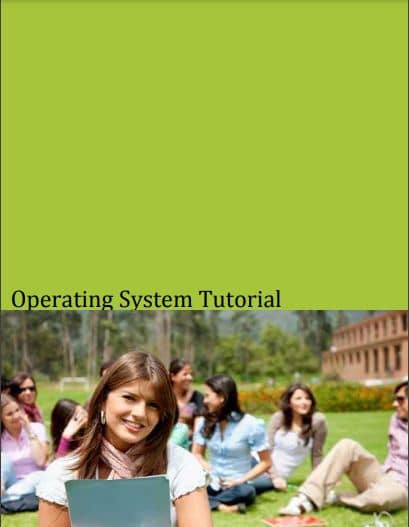‘Operating System Tutorial’ PDF Quick download link is given at the bottom of this article. You can see the PDF demo, size of the PDF, page numbers, and direct download Free PDF of ‘Operating System Tutorial’ using the download button.
Operating System Tutorial PDF Free Download

Time-sharing operating systems
Time-sharing is a technique that enables many people, located at various terminals, to use a particular computer system at the same time.
Time-sharing or multitasking is a logical extension of multiprogramming.
Processor’s time which is shared among multiple users simultaneously is termed as time-sharing.
The main difference between Multi programmed Batch Systems and Time-Sharing Systems is that in the case of multi-programmed batch systems, the objective is to maximize processor use, whereas in Time-Sharing Systems objective is to minimize response time.
Multiple jobs are executed by the CPU by switching between them, but the switches occur so frequently. Thus, the user can receive an immediate response.
For example, in transaction processing, the processor executes each user program in a short burst or quantum of computation.
If n users are present, each user can get a time quantum. When the user submits the command, the response time is in a few seconds at most.
The operating system uses CPU scheduling and multiprogramming to provide each user with a small portion of the time.
Computer systems that were designed primarily as batch systems have been modified into time-sharing systems.
Distributed systems use multiple central processors to serve multiple real-time applications and multiple users.
Data processing jobs are distributed among the processors accordingly to which one can perform each job most efficiently.
The processors communicate with one another through various communication lines (such as high-speed buses or telephone lines).
These are referred to as loosely coupled systems or distributed systems.
Processors in a distributed system may vary in size and function. These processors are referred to as sites, nodes, computers, and so on.
The advantages of distributed systems are following. With a resource-sharing facility users at one site may be able to use the resources available at another.
Speed up the exchange of data with one another via electronic mail.
If one site fails in a distributed system, the remaining sites can potentially continue operating.
Better service to the customers. Reduction of the load on the host computer.
Time sharing is a technique which enables many people, located at various terminals, to use a particular computer system at the same time.
Time-sharing or multitasking is a logical extension of multiprogramming.
Processor’s time which is shared among multiple users simultaneously is termed as time-sharing.
The main difference between Multiprogrammed Batch Systems and Time-Sharing Systems is that in case of multiprogrammed batch systems, objective is to maximize processor use, whereas in Time-Sharing Systems objective is to minimize response time.
Multiple jobs are executed by the CPU by switching between them, but the switches occur so frequently. Thus, the user can receive an immediate response.
For example, in a transaction processing, processor execute each user program in a short burst or quantum of computation.
That is if n users are present, each user can get time quantum. When the user submits the command, the response time is in few seconds at most.
Operating system uses CPU scheduling and multiprogramming to provide each user with a small portion of a time.
Computer systems that were designed primarily as batch systems have been modified to time-sharing systems.
| Writer | Tutorials Point |
| Language | English |
| Pages | 97 |
| Pdf Size | 1.89 MB |
| Category | Computer |
| Sources | sncwgs.ac.in |
Operating System Tutorial PDF Free Download
